A Symmetry Particle Method towards Implicit Non‐Newtonian Fluids
Abstract
:1. Introduction
2. Related Works
3. Material Model
3.1. Governing Equations
3.2. Carreau-Yasuda Model
3.3. Smoothed Particle Hydrodynamics
4. Pressure Projection Algorithm
| Algorithm 1. Pressure Projection Algorithm |
| for all particles do update using Equation (7) update using Equation (21) end for for all particles do update using Equation (12) end for while () or do for all particles do update using Equation (20) update using Equation (21) end for end while for all particles do end for |
5. Implicit Viscosity Solver
| Algorithm 2. Implicit non-Newtonian SPH fluid solver |
| for all particles do find neighborhoods compute time step size end for for all particles do compute the external force end for for all particles do update velocity end for for all particles do compute the external force end for for all particles do update velocity end for for all particles do compute the pressure and pressure force end for for all particles do update velocity // Pressure Projection end for for all particles do solving viscosity system end for for all particles do end for |
6. Implementation and Results
7. Conclusions
Acknowledgments
Author Contributions
Conflicts of Interest
References
- Ellero, M.; Tanner, R.I. SPH simulations of transient viscoelastic flows at low Reynolds number. J. Non-Newton. Fluid Mech. 2005, 132, 61–72. [Google Scholar] [CrossRef]
- Müller, M.; Charypar, D.; Gross, M. Particle-based fluid simulation for interactive applications. In Proceedings of the 2003 ACM SIGGRAPH/Eurographics Symposium on Computer Animation, San Diego, CA, USA, 26–27 July 2003; Eurographics Association Press: Aire-la-Ville, Switzerland, 2003; pp. 154–159. [Google Scholar]
- Shadloo, M.S.; Oger, G.; Le Touzé, D. Smoothed particle hydrodynamics method for fluid flows, towards industrial applications: Motivations, current state, and challenges. Comput. Fluids 2016, 136, 11–34. [Google Scholar] [CrossRef]
- Sadek, S.H.; Yildiz, M. Modeling Die Swell of Second-Order Fluids Using Smoothed Particle Hydrodynamics. J. Fluids Eng. 2013, 135, 051103. [Google Scholar] [CrossRef]
- Zainali, A.; Tofighi, N.; Shadloo, M.S.; Yildiz, M. Numerical investigation of Newtonian and non-Newtonian multiphase flows using ISPH method. Comput. Methods Appl. Mech. Eng. 2013, 254, 99–113. [Google Scholar] [CrossRef]
- Price, D.J. Modelling discontinuities and Kelvin–Helmholtz instabilities in SPH. J. Comput. Phys. 2008, 227, 10040–10057. [Google Scholar] [CrossRef]
- Hayhurst, C.J.; Clegg, R.A. Cylindrically symmetric SPH simulations of hypervelocity impacts on thin plates. Int. J. Impact Eng. 1997, 20, 337–348. [Google Scholar] [CrossRef]
- Omang, M.; Børve, S.; Trulsen, J. Alternative kernel functions for Smoothed Particle Hydrodynamics in cylindrical symmetry. Shock Waves 2005, 14, 293–298. [Google Scholar] [CrossRef]
- Ren, J.; Ouyang, J.; Jiang, T.; Li, Q. A corrected symmetric SPH method to simulate viscoelastic free surface flows based on the PTT model. Int. J. Numer. Methods Fluids 2012, 70, 1494–1517. [Google Scholar] [CrossRef]
- Monaghan, J.J. Simulating free surface flows with SPH. J. Comput. Phys. 1994, 110, 399–406. [Google Scholar] [CrossRef]
- Shao, S.; Lo, E.Y.M. Incompressible SPH method for simulating Newtonian and non-Newtonian flows with a free surface. Adv. Water Resour. 2003, 26, 787–800. [Google Scholar] [CrossRef]
- Bridson, R.; Fedkiw, R.; Müller-Fischer, M. Fluid simulation: SIGGRAPH 2006 course notes Fedkiw and Muller-Fischer presenation videos are available from the citation page. In Proceedings of the SIGGRAPH '06 Special Interest Group on Computer Graphics and Interactive Techniques Conference, Boston, MA, USA, 30 July–3 August 2006.
- Goktekin, T.G.; Bargteil, A.W.; O’Brien, J.F. A Method for Animating Viscoelastic Fluids. ACM Trans. Graph. 2004, 23, 461–466. [Google Scholar] [CrossRef]
- Losasso, F.; Shinar, T.; Selle, A.; Fedkiw, R. Multiple interacting liquids. ACM Trans. Graph. 2006, 25, 812–819. [Google Scholar] [CrossRef]
- Batty, C.; Bridson, R. Accurate Viscous Free Surfaces for Buckling, Coiling, and Rotating Liquids. In Proceedings of the 2008 Eurographics/ACM SIGGRAPH Symposium on Computer Animation, SCA 2008, Dublin, Ireland, 7–9 July 2008; pp. 219–228.
- Bergou, M.; Audoly, B.; Vouga, E.; Wardetzky, M.; Grinspun, E. Discrete viscous threads. ACM Trans. Graph. 2010, 29, 157–166. [Google Scholar] [CrossRef]
- Batty, C.; Uribe, A.; Audoly, B.; Grinspun, E. Discrete Viscous Sheets. ACM Trans. Graph. 2012, 31, 13–15. [Google Scholar] [CrossRef]
- Xu, X.; Ouyang, J.; Yang, B.; Liu, Z. SPH simulations of three-dimensional non-Newtonian free surface flows. Comput. Methods Appl. Mech. Eng. 2013, 256, 101–116. [Google Scholar] [CrossRef]
- Pan, W.; Tartakovsky, A.M.; Monaghan, J.J. Smoothed particle hydrodynamics non-Newtonian model for ice-sheet and ice-shelf dynamics. J. Comput. Phys. 2013, 242, 828–842. [Google Scholar] [CrossRef]
- Müller, M.; Keiser, R.; Nealen, A.; Pauly, M.; Gross, M.; Alexa, M. Point based animation of elastic, plastic and melting objects. In Proceedings of the ACM Siggraph/eurographics Symposium on Computer Animation, Grenoble, France, 27–29 August 2004; Eurographics Association: Aire-la-Ville, Switzerland, 2004; pp. 141–151. [Google Scholar]
- Afonso, P.; Fabiano, P.; Thomas, L.; Geovan, T. Particle-based viscoplastic fluid/solid simulation. Comput.-Aided Des. 2009, 41, 306–314. [Google Scholar]
- Paiva, A.; Petronetto, F.; Lewiner, T.; Tavares, G. Particle-based non-Newtonian fluid animation for melting objects. In Proceedings of the 2006 19th Brazilian Symposium on Computer Graphics and Image Processing, Manaus, Brazil, 8–11 October 2006; pp. 78–85.
- Rafiee, A.; Manzari, M.T.; Hosseini, M. An incompressible SPH method for simulation of unsteady viscoelastic free-surface flows. Int. J. Non-Linear Mech. 2007, 42, 1210–1223. [Google Scholar] [CrossRef]
- Fan, X.J.; Tanner, R.I.; Zheng, R. Smoothed particle hydrodynamics simulation of non-Newtonian moulding flow. J. Non-Newton. Fluid Mech. 2010, 165, 219–226. [Google Scholar] [CrossRef]
- De Andrade, L.F.S.; Sandim, M.; Petronetto, F.; Pagliosa, P.; Paiva, A. SPH Fluids for Viscous Jet Buckling. In Proceedings of the Graphics, Patterns and Images, Rio de Janeiro, Brazil, 26–30 August 2014; pp. 65–72.
- Zhang, Y.; Ban, X.; Wang, X.; Liu, X. A Density-Correction Method for Particle-Based Non-Newtonian Fluid. In Cooperative Design, Visualization, and Engineering; Springer: Heidelberg, Germany, 2016. [Google Scholar]
- Zhu, B.; Lee, M.; Quigley, E.; Fedkiw, R. Codimensional non-Newtonian fluids. ACM Trans. Graph. 2015, 34, 1–9. [Google Scholar] [CrossRef]
- Solenthaler, B.; Pajarola, R. Predictive-corrective incompressible SPH. ACM Trans. Graph. 2009, 28, 341–352. [Google Scholar] [CrossRef] [Green Version]
- Ihmsen, M.; Cornelis, J.; Solenthaler, B.; Horvath, C.; Teschner, M. Implicit Incompressible SPH. IEEE Trans. Vis. Comput. Graph. 2014, 20, 426–435. [Google Scholar] [CrossRef] [PubMed]
- Bender, J.; Koschier, D. Divergence-free smoothed particle hydrodynamics. In Proceedings of the 14th ACM SIGGRAPH/Eurographics Symposium on Computer Animation, Los Angeles, CA, USA, 07–09 August 2015; Eurographics Association Press: Aire-la-Ville, Switzerland, 2015; pp. 147–155. [Google Scholar]
- Becker, M.; Teschner, M. Weakly compressible SPH for free surface flows. In Proceedings of the ACM Siggraph/eurographics Symposium on Computer Animation, SCA 2007, San Diego, CA, USA, 2–4 August 2007; pp. 209–217.
- Macosko, C.W.; Larson, R.G. Rheology: Principles, Measurements, and Applications; Wiley: New York, NY, USA, 1994. [Google Scholar]
- Morris, J.P.; Fox, P.J.; Zhu, Y. Modeling low Reynolds number incompressible flows using SPH. J. Comput. Phys. 1997, 136, 214–226. [Google Scholar] [CrossRef]
- Ihmsen, M.; Akinci, N.; Becker, M.; Matthias, T. A Parallel SPH Implementation on Multi-Core CPUs. Comput. Graph. Forum 2011, 30, 99–112. [Google Scholar] [CrossRef]
- Monaghan, J.J. Smoothed particle hydrodynamics. Annu. Rev. Astron. Astrophys. 1992, 30, 543–574. [Google Scholar] [CrossRef]
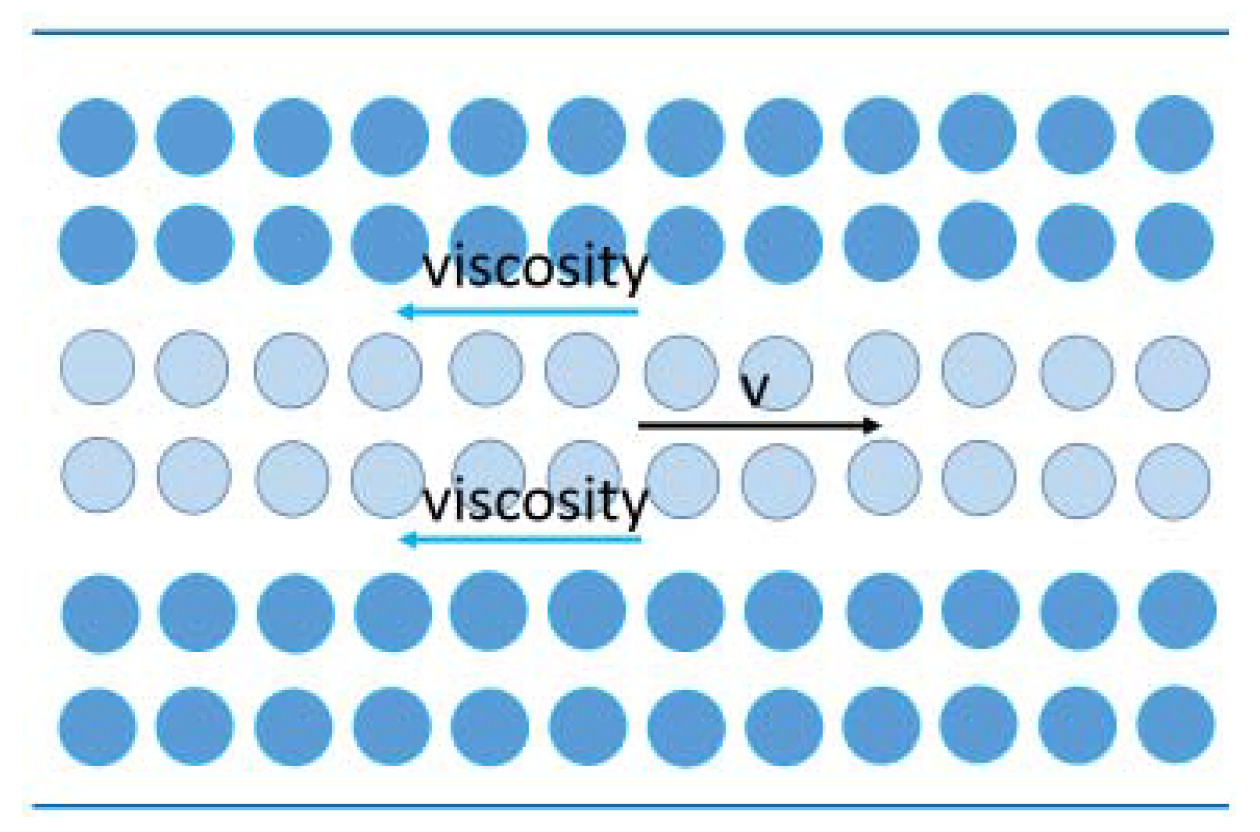
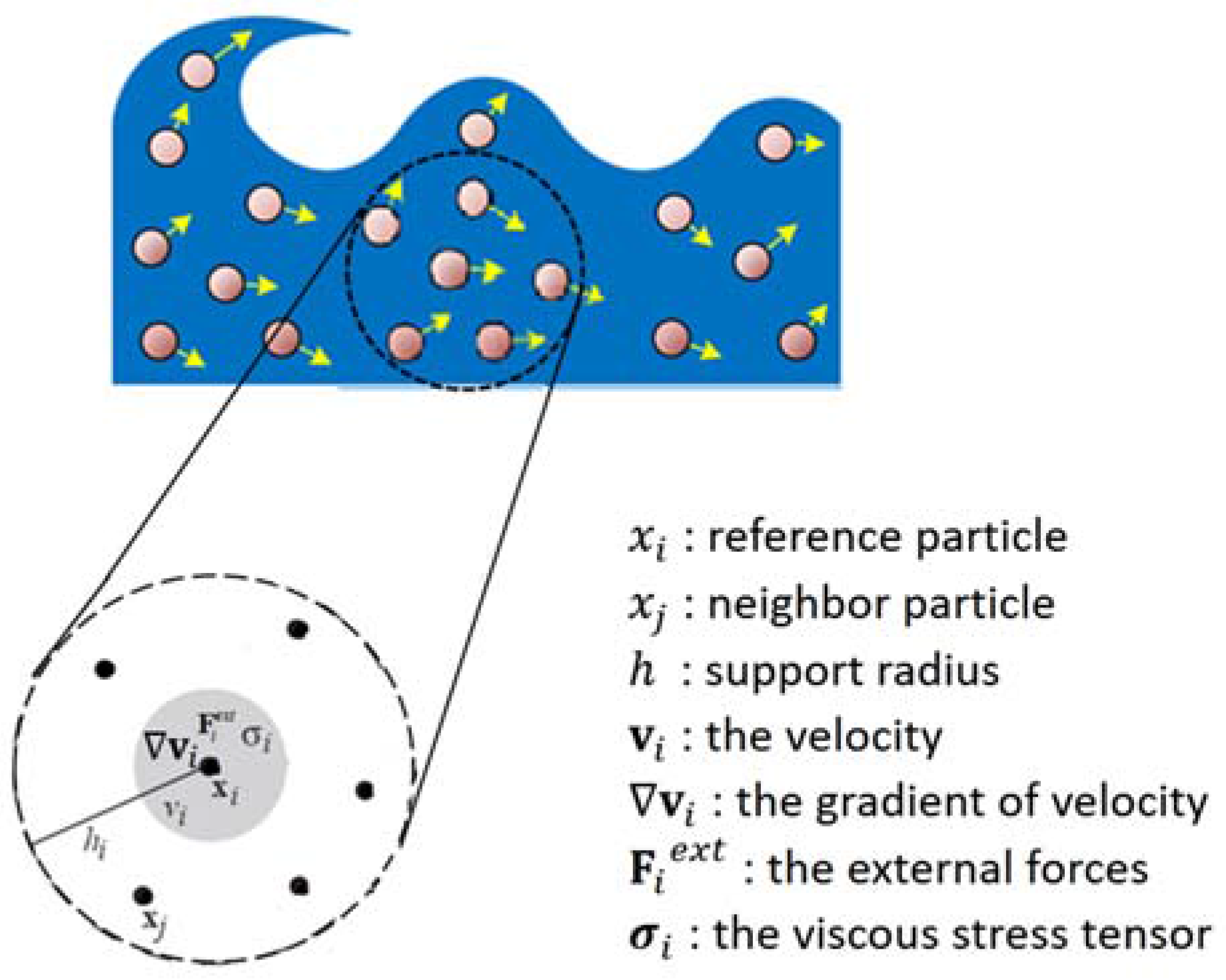
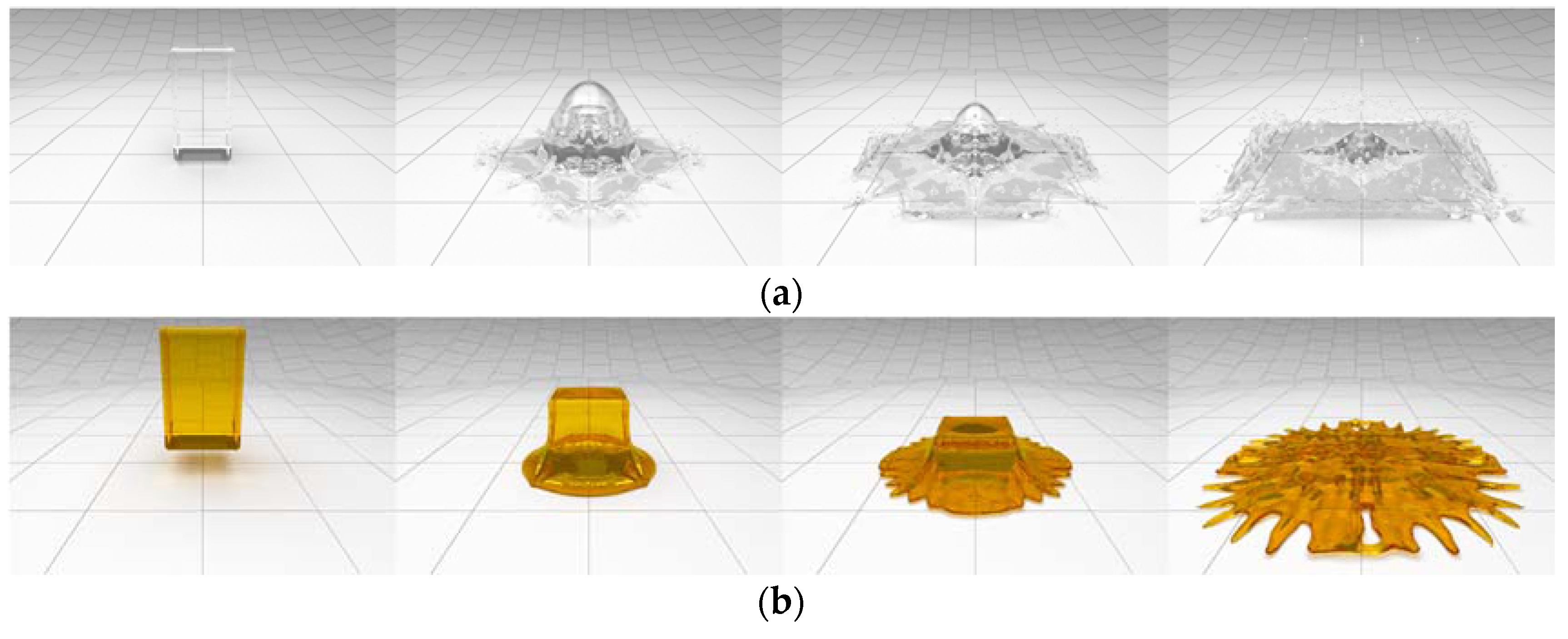
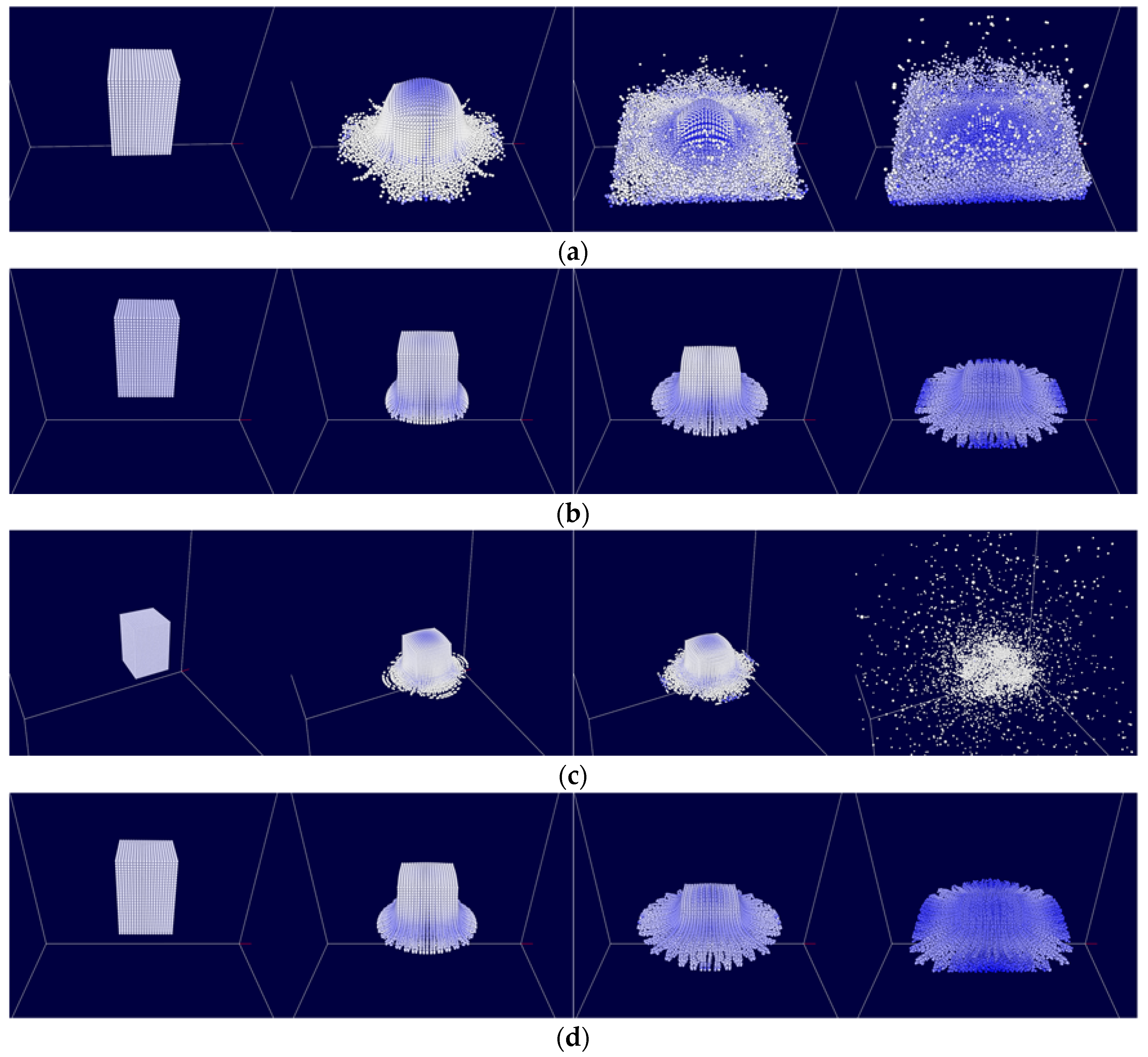
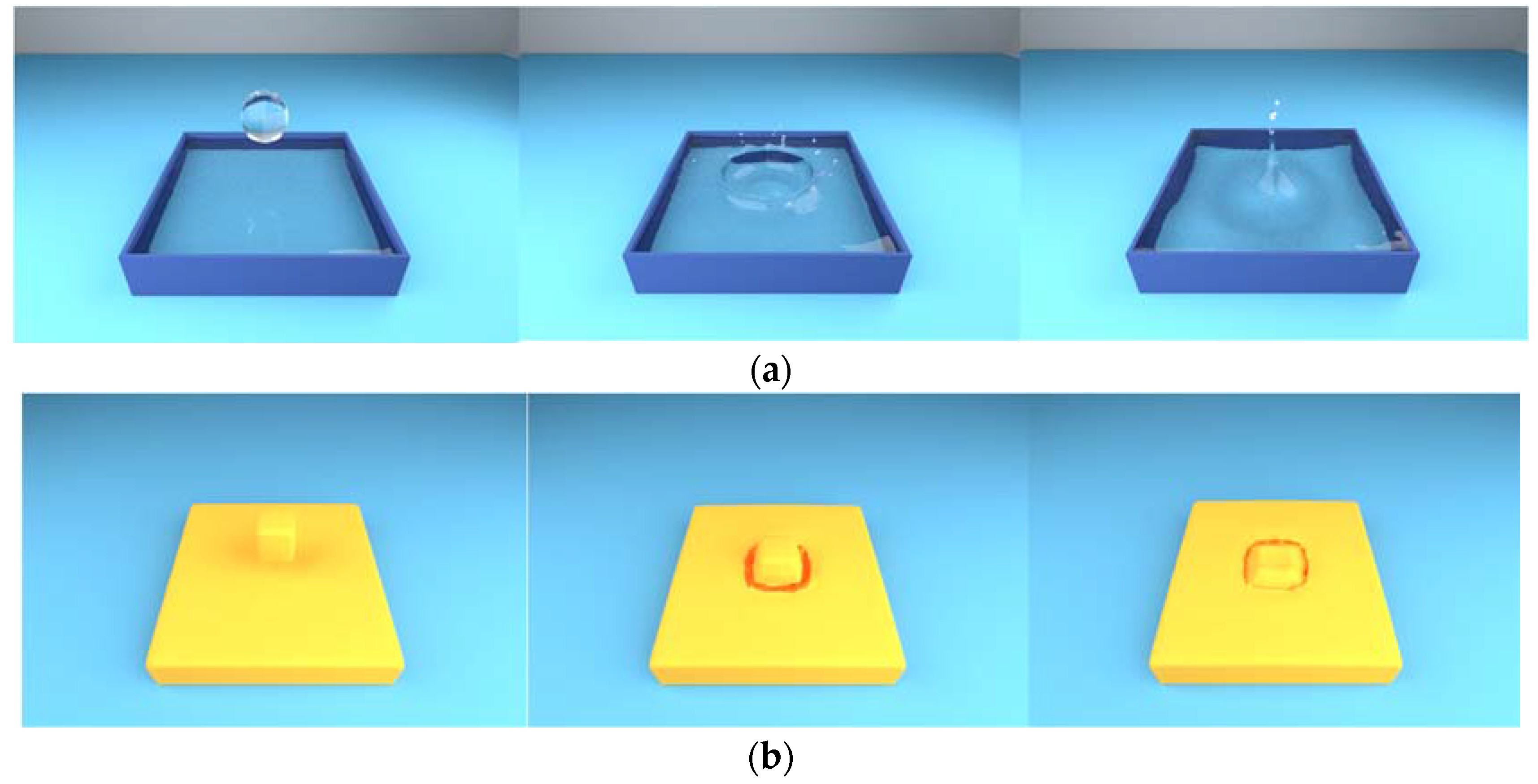
| Simulation domain size | 6 m × 6 m × 6 m |
| Fluid particles | 13,671 |
| Smoothing kernel function | cubic splines |
| Smoothing radius | 0.1 m |
| Fluid particle width | 0.05 m |
| Rendering time(per frame) | 1.14 min |
| Simulation domain size | 8 m × 8 m × 8 m |
| Fluid particles | 32,751 |
| Smoothing kernel function | cubic splines |
| Smoothing radius | 0.2 m |
| Fluid particle width | 0.1 m |
| Rendering time(per frame) | 3.85 min |
| Figure | |||||||
|---|---|---|---|---|---|---|---|
| Figure 4a | - | 0.2 | - | - | 1 | 3.0 × 10−4 | 40.8 |
| Figure 4b | 2 | 0.2 | 1 | 0.5 | −0.5 | 2.5 × 10−6 | 53.3 |
| Figure 4c | 2 | 0.2 | 1 | 0.5 | −0.5 | 3.0 × 10−4 | - |
| Figure 4d | 2 | 0.2 | 1 | 0.5 | −0.5 | 3.0 × 10−4 | 83.4 |
| Figure 5a | - | 0.2 | - | - | 1 | 6.0 × 10−4 | 178 |
| Figure 5b | 0.2 | 2 | 1 | 0.5 | −0.5 | 6.0 × 10−4 | 216 |
© 2017 by the authors. Licensee MDPI, Basel, Switzerland. This article is an open access article distributed under the terms and conditions of the Creative Commons Attribution (CC BY) license ( http://creativecommons.org/licenses/by/4.0/).
Share and Cite
Zhang, Y.; Ban, X.; Wang, X.; Liu, X. A Symmetry Particle Method towards Implicit Non‐Newtonian Fluids. Symmetry 2017, 9, 26. https://doi.org/10.3390/sym9020026
Zhang Y, Ban X, Wang X, Liu X. A Symmetry Particle Method towards Implicit Non‐Newtonian Fluids. Symmetry. 2017; 9(2):26. https://doi.org/10.3390/sym9020026
Chicago/Turabian StyleZhang, Yalan, Xiaojuan Ban, Xiaokun Wang, and Xing Liu. 2017. "A Symmetry Particle Method towards Implicit Non‐Newtonian Fluids" Symmetry 9, no. 2: 26. https://doi.org/10.3390/sym9020026




